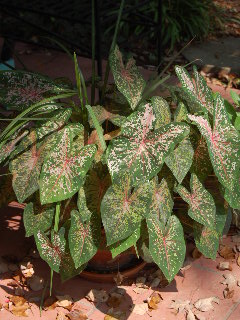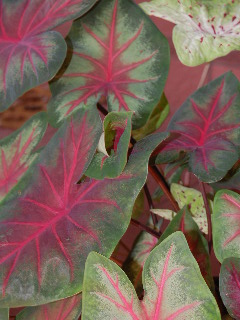
A popular foliage plant, grown for its beautifully multi-colored veined leaves, the caladium works well as a houseplant or planted outdoors in temperate climates.
The caladium plant is a member of the Arum family. It is sometimes incorrectly called elephant’s ear, a similarly shaped though generally larger-leaved foliage plant which belongs to the Colocasia family.
Another inaccuracy in identifying and labeling the caladium is that it is often called a bulb, while in reality it is actually a “tuber-corm”. Tubers are fatty underground stems with “eyes”, which are the buds of the growing plant. The tuber-corms are rounded, often flattened tubers that have a rather uneven lumpy appearance, with a pointed bud on the top and hair-like roots growing from the bottom, top, and sides of the plant.
Caladiums also differ from bulbs in their growing requirements. Most of the bulbs, particularly the summer-blooming ones such as the gladioli, do well in conditions of full sun and a rich well-drained soil. The caladiums prefer shade to partial-shade and an evenly moist, organically rich soil.
Caladiums also like a soil that is somewhat acid, much as the azaleas do, and if in fact you have a partially shaded azalea bed that is heavily mulched with pine needles, a scattering of brightly colored caladiums incorporated into the area during the warmer months makes for a spectacular show.
If you do plan to add caladiums to your outdoor garden, they should be set a couple of inches deep and planted after all danger of frost is past. As the tuber-corms are sometimes difficult to start, you might want to give them an initial boost by planting them indoors in small pots. After the growing shoots push through the surface, you can transplant into the outdoor garden.

The caladiums range in height from 8 to 20 inches and sometimes more, with their large heart-shaped leaves fanning from the leggy stems. The beauty of this plant lies in the delicate veining of the leaves and in the varied coloring which ranges from green to pink with streaks of white, darker green, and sometimes even black.
The plants are not hardy in colder growing areas, and if you plan to save and re-plant them from year to year, the tuber-corms should be dug up in the fall, allowed to air dry and then over-wintered in an indoor location, safe from freezing temperatures. Caladiums do not thrive where daytime temperatures are often consistently below 70 degrees Fahrenheit, as they are actually native to the tropics, where they can be found growing wild in their natural environment of shade and humidity.
Caladiums can be propagated by division. The easiest way to do this is with a good sharp knife, slicing the tuber-corms through into pieces, always making sure that each section has a living bud (eye) from which the new plant will grow. You can dust the cut edges with a sulfur powder (available at your garden center) to prevent rotting. If the tuber-corms you are working with are quite healthy, you should have good growth the very next season on your newly divided caladiums. By using this method of division and replanting, you will soon have a garden full of beautiful colorful caladium leaves.
Caladiums work great planted directly into your garden in shaded areas, but they also make showy container plantings, mixed in with trailing ivy or other plants of contrasting colors or textures. Just remember the basic rules of plenty of moisture and shade and temperatures that are not too cool.
 A popular foliage plant, grown for its beautifully multi-colored veined leaves, the caladium works well as a houseplant or planted outdoors in temperate climates.
A popular foliage plant, grown for its beautifully multi-colored veined leaves, the caladium works well as a houseplant or planted outdoors in temperate climates.
 The caladiums range in height from 8 to 20 inches and sometimes more, with their large heart-shaped leaves fanning from the leggy stems. The beauty of this plant lies in the delicate veining of the leaves and in the varied coloring which ranges from green to pink with streaks of white, darker green, and sometimes even black.
The caladiums range in height from 8 to 20 inches and sometimes more, with their large heart-shaped leaves fanning from the leggy stems. The beauty of this plant lies in the delicate veining of the leaves and in the varied coloring which ranges from green to pink with streaks of white, darker green, and sometimes even black.